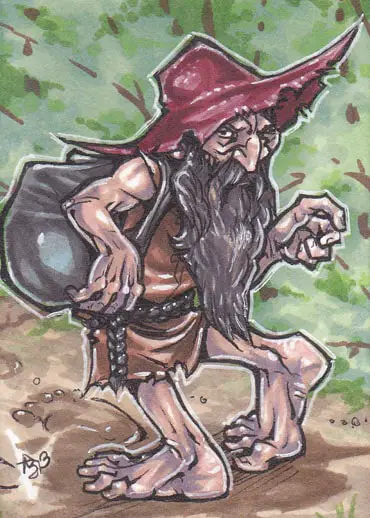Are you fascinated by the mystical and magical tales from folklore? Let’s dive into the realm of Duende, a mythical being known as the ‘master of the house’ in Iberian, Latin American, and Ibero American cultures.
We hope to offer an exciting exploration into this mysterious creature’s origin and powerful influence within numerous societies. Get ready to be amazed by these enchanted stories of El Duende!
Key Takeaways
- Duende is a mythical being known as the ‘master of the house’ in Iberian, Latin American, and Ibero American cultures.
- It originated in Spain and Portugal before becoming a significant figure in Latin American folklore.
- Duendes are believed to have magical powers, can change shapes, and look out for animals and plants in the wild. They can bring good luck or mischief depending on their mood.
The Origin of Duende in Folklore
Duende originated in Spain, Portugal, and eventually made its way to Latin America where it became a significant figure in folklore.
Spain
Spain is home to many types of duendes. These small beings are a big part of the stories people tell here. Some duendes in Spain are categorized as Anjanas, Busgosos, and Diaños. Others include Enanos, Elfos, Hadas, Nomos, Nuberos, Tentirujus, Trasgos.
There are also Trastolillos, Trentis ,Tronantes ,and Ventolines. Each has its own tale and traits that make it special. For example, Anjanas are very pretty and have long hair like nymphs in Ancient Greece.
Many Spanish tales talk about these duendes and their deeds.

Portugal
Portugal plays a key role in the story of Duende. This is a small, mythical being from folklore. In Portugal, these beings have different looks and traits.
Duendes are known for making noise at night to scare people. They can move things around when you’re not looking. Many believe they guard treasure hidden deep under the ground. They look like tiny old men dressed in green suits and sombreros.
Tourists often hear tales about them during their visits to rural villages and remote roads.
Latin America
Latin America is full of amazing tales. One such tale is about a mythical being called Duende. This creature comes from Latin American folklore. It’s also found in stories from Spain, Portugal, the Philippines and Mariana Islands.
Every region shows Duende in a unique way. But this creature always looks like a person, small and odd. In some places like Copán Ruinas in western Honduras, people see El Duende as evil!
So get set to learn more about these exciting folks tales on your trip.
The Power and Mystery of Duende
Duende holds a significant role in Latin American folklore, captivating the imagination with its mysterious powers and mythical presence.
Role in Latin American Folklore
Duendes hold a big place in Latin American folklore. These beings have magical gifts. Some people see them as fun, while others think they cause trouble. They can change shapes and vanish at will.
Also, Duendes are believed to look out for animals and plants in the wild. You might hear tales of duendes creating mischief or giving wealth to folks who treat them well. In some places, they are seen as guardians that keep nature safe from harm.
Common Beliefs and Myths
Duende, the mysterious and powerful creature found in Latin American folklore, is surrounded by a variety of common beliefs and myths.
Here are some important facts about duendes that you should know:
- Duendes are often believed to be mischievous spirits or mythical beings that dwell in remote areas like rural villages, nance trees, and even cow dung.
- They are said to have the power to bring good luck or cause mischief depending on their mood.
- Duendes are sometimes portrayed as small creatures with unique physical features, such as four fingers but no thumb.
- According to traditional beliefs, duendes can become invisible or transform into other objects like red clay or animal skins.
- It is believed that duendes have a particular interest in single women. They may offer gifts and wealth to entice them away but could also use evil powers if rejected.
- Many people still fear encountering duendes due to their association with the unknown and supernatural.
The Impact of Duende on Literature and Popular Culture
Duende has had a big impact on literature and popular culture, especially in Latin American folklore. It is often portrayed as a mysterious and powerful being in books, movies, and music.
Its presence adds excitement and fascination to these stories. Duende has inspired many works of art and writing, showcasing its influence on creativity and imagination.
People have even incorporated duende into theater performances and films to preserve and promote Latin American traditions.
Conclusion
In conclusion, the power of El Duende in Latin American folklore is a captivating and enigmatic phenomenon. These mythical beings have been deeply ingrained in the cultural history of Spain, Portugal, and Latin America for centuries.
From their origins as guardians of hidden treasures to their mischievous antics in rural villages, duendes continue to fascinate and mystify both locals and tourists alike. Exploring the rich tapestry of duende legends reveals a world where supernatural beings blur the line between reality and imagination, leaving us with an enduring sense of wonder and awe.
How Does El Duende Compare to Maya Folklore in Latin America?
El Duende, a mythical creature in Latin American folklore, shares similarities with the Maya mythology of the ancient Maya people in Belize history. Both encompass supernatural beings and spirits that are believed to interact with the human world. These folklore traditions reveal a rich cultural heritage in Latin America.
FAQs
1. What is El Duende in Latin American folklore?
El Duende is a mythological being from Latin American Folklore. It looks like gnomes, dwarves or leprechauns and could be seen as an evil being or guardian spirit.
2. Who are some famous people that mentioned El Duende?
Famous personalities Federico García Lorca, Giannina Braschi, Tracy K. Smith have referred to El Duende within a flamenco cultural context.
3. Is it true that the Belizean Tata Duende can transform into red clay?
Yes! According to Ambergris Caye of Belize stories, Tata duende has the power to change into red clay just like Mayan artifacts were made up of!
Additionally, the Tata Duende of Belize is described as having backwards feet and wearing a large red hat.

4. What kind of creature does Apabardexu refer to in Castilian duendes?
Apabardexu refers to humanoid figures in Spanish folklore known as Ojancanus and Xanas.
5. Are there any special habits we know about these folklore creatures?
There are many tales! Some say they are mute or mentally impaired but still do evil things out of the greed of peasants; while others believe them as playboys who carry a basket filled with water!
6. Can you tell us more about San Pedro’s folklore on Evil Being?
In San Pedro’s folklores, El Dueno del Monte was known for his wide brimmed hat and was very protective towards animals especially against those killing birds during hunting for bird nests.





